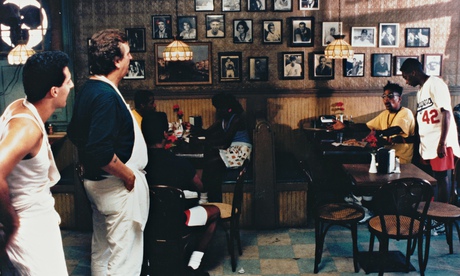
Ernest R Dickerson, cinematographer
While we were shooting School Daze, Spike Lee's second feature film, he told me he was writing something called Heatwave, as Do the Right Thing was initially known. He wanted me to think about how to visually portray heat, how to get the audience to feel the hottest day of summer. The first thing I came up with was the use of colour. I did a lot of research on its psychology and worked on a controlled palette that pretty much stayed in the warm range – yellows, reds, earth tones, ambers – and tried to stay away from blues and greens, which have a cooling effect.
Spike and I had met at NYU grad school. Before we started a film, we would have movie-watching sessions, to get on the same page, to find the vocabulary we wanted. For this, we looked at The Third Man, for the canted angles, and then the cinematography of Jack Cardiff, who worked on Black Narcissus, A Matter of Life and Death and The Red Shoes. The use of colour in those films still inspires me.
I knew our biggest challenge was going to be shooting over eight weeks and making it look like one day. We looked for a street that ran north-south. Since the sun travels east to west, one side would always be in shade. That way, when we had to shoot on cloudy days, I could just make it look like we were in the shaded side of the street. That really saved us, because the first two weeks we had a lot of rain. Some shots where it looks sunny – you can actually see rain if you look really hard.
The movie doesn't go outside that one block, meaning a lot of the actors were there every single day. No matter where you are, you can always see down the street, so Ossie Davis [Da Mayor] always had to be there on his stoop. Also, through the window of Sal's pizza parlour, you could always see the Korean shopowners across the street, and so on. For a while, it was a real living, breathing community. That builds a very special bond. We all believed in the film. Things got a little heated during the riot scene, but it was a great set. There were so many people who'd been in School Daze and would go on to be in other Spike Lee films – so the Spike Lee repertory company was in full effect.
We didn't think we were making anything controversial. We just thought we were making a film saying some things about things that were really going on. A couple of critics predicted the film would cause riots across America, but we didn't believe it and we were right. Nothing ever happened. Are things better now? I'm not sure. A lot of people think of post-racial America now Barack Obama's president. I'm continually appalled at the level of disrespect he's shown by so many people. Whenever I hear the phrase, "We need to take our country back", I get angry.
Reading this on mobile? Click here to view video
Giancarlo Esposito, played Buggin' Out
We had just finished doing School Daze when Spike gave me a call. When I first read the script, I thought it was one of the best things he'd ever written. It didn't soft-pedal anything, but it's incredibly even-handed when it could have been much more one-sided.
I was living in Manhattan, but when we shot the movie I moved out to Brooklyn. My background is half-Italian and in those days, being a lighter-skinned black man, I couldn't get cast as a white person or a black person. So I was playing Spanish roles. This follows me to this day: a lot of people are shocked to realise Buggin' Out and Gus Fring [from Breaking Bad] are the same person. So Spike gave me the opportunity to play black. During the scene with John Savage, when he steps on my new sneakers, Spike said: "It's good, but you talk too fast, you gotta slow it down a little." I said: "Buggin' Out talks fast!" I got the vote of confidence from Spike to do the role how I wanted to.
The whole look and rhythm of the movie is like a heightened reality: I think that's what makes it so special. The characters are just slightly larger than life. What made that feeling happen? I think it was where we were all at. We were very nervous. I mean, we're doing a movie about racial tension in New York when things aren't really good. We had Tawana Brawley [who claimed to have been raped by six white men] going on, and Al Sharpton trying to bring justice to her cause [a grand jury later concluded the allegations were false]. It was a very particular moment in time when Spike decided to tell that story.
The riot stuff at the end was scary. When you have to get physical, something takes over: there were some intense moments, with people getting in touch with how they really felt. With Danny Aiello, who played Sal, I was cursing him and he was cursing me and all of our lives flashed past us. We ended up crying in each other's arms because we'd said some horrible things to each other. We looked back to Spike to say: "Was that what you wanted?" He was behind the camera with his arms outstretched, punching the sky.
We all went back there for a photo-shoot recently: Sam Jackson, Rosie Perez, Bill Nunn, Ruby Dee. That block is beautiful now, gentrified. I don't believe even I could afford to live there. Someone was coming out of the door where John Savage stepped on my sneakers, and Spike turned to me and said: "Uh-oh, Buggin' Out, look out!"

